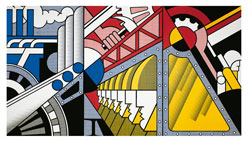5.1
Middle Years Activity
Formal Interpretation

Roy LICHTENSTEIN
American 1923–97
Preparedness 1968
oil and Magna on canvas, 3 panels
304.8 x 548.7 cm
Solomon R. Guggenheim Museum, New York
© Roy Lichtenstein/LICHTENSTEIN, New York. Licensed by VISCOPY Australia
69.1885
For |
Middle Years Students |
Curriculum |
Art |
Aim |
Exploring formal elements and principles of design. |
Preparation |
To do this activity you will need to:
You will need the following materials:
|
Individual Task |
Place tracing paper over a reproduction of this work and separately identify these formal elements and design principles:
|
Discussion Questions |
Repetition: Where does the repetition of shape create rhythm? How many places can you see repetition in the composition? Comment on the way Lichtenstein has created the illusion of reflective glass in the airplane window in the third panel. What are the main shapes you see in this work? How do they create visual strength in the composition? |